My shrubs and woody perennials: Alive, dead or in-between? Evaluating plants 2 months after Texas freeze
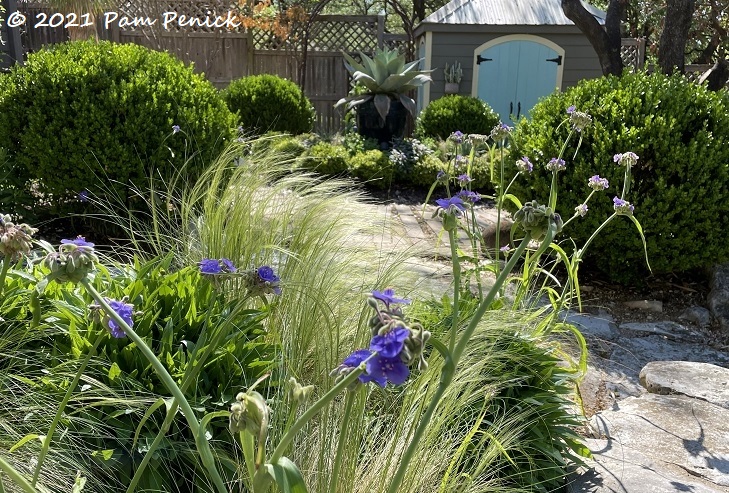
Texas gardeners are feverishly comparing notes about plant survivors and croakers after February’s Big Freeze. I’m doing the same and documenting how every plant in my garden fared. Please see my first post in this series for the introduction and to learn how my trees are doing. Today I’m taking a look at my shrubs, sub-shrubs (like Salvia greggii), and woody perennials, a large plant group in my garden that, truth be told, took a big hit.
Asterisks indicate plants native to Texas. Plants that were stunted, maimed, or killed by the freeze are in bold, for easier searching.
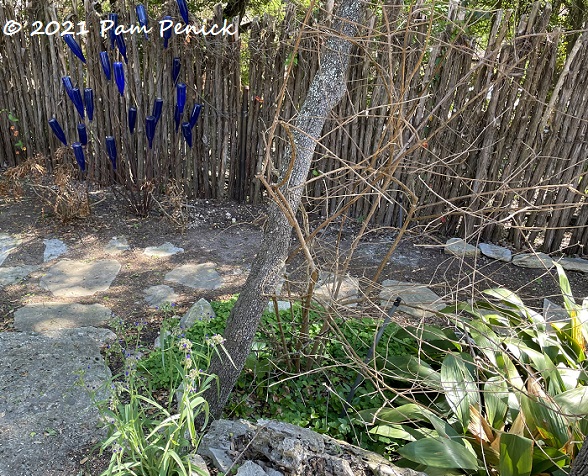
Shrubs, Sub-Shrubs, & Woody Perennials
- Abutilon – Flowering maple: ‘Bartley Schwarz’: Killed to the ground but coming back well from the roots.
- Ageratina havanensis – Shrubby white boneset, or white mistflower*: Died back, as per normal. I cut it back hard, and it’s coming back quickly.
- Aloysia virgata – Sweet almond verbena: Killed — at least, it looked completely dead when I removed it last week. I love the fragrance of its flowers, but it’s a big, coarse-leaved plant that had grown too large for the space. So I took the opportunity to remove it.
- Anisacanthus quadrifidus var. wrightii – Flame acanthus*: Died back, as per normal. I cut it back hard, and it’s coming back quickly.
- Artemisia ‘Powis Castle’: Died back, as per normal. I cut it back hard, and it’s coming back quickly.
- Buxus microphylla var. japonica ‘Gregem’ – ‘Baby Gem’ boxwood: Completely unfazed.
- Buxus sinica var. insularis ‘Winter Gem’ – ‘Winter Gem’ boxwood: Completely unfazed.
- Callicarpa acuminata – Mexican beautyberry, or black beautyberry: Killed to the ground with branches sloughing off bark. As of this week, sprigs of green are coming up from the roots.
- Callicarpa americana – American beautyberry*: Completely unfazed and leafing out normally.
- Cephalotaxus harringtonia ‘Prostrata’ – Spreading Japanese plum yew: Completely unfazed.
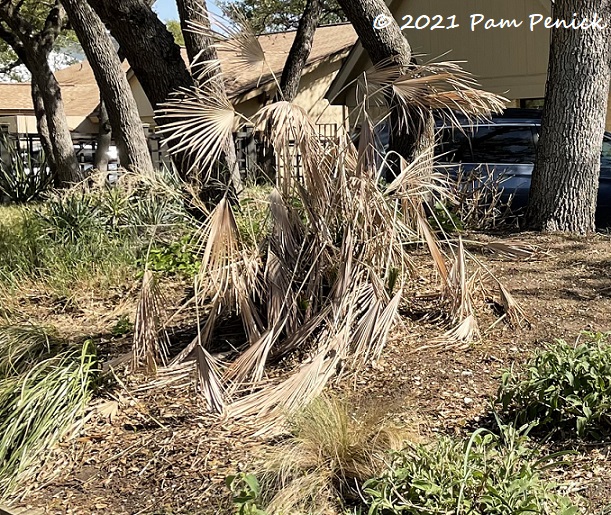
- Chamaerops humilis – Mediterranean fan palm: Seriously maimed. The fronds turned brown and collapsed, and I cut them off, leaving a few on the trunk crown to avoid removing anything green. I’ve been watching anxiously to see if the crown will show any green, indicating that the main trunk will releaf. It’s surprisingly hard to tell, or maybe I just don’t want to face facts. So far, I’m seeing only a faint tinge of green (maybe?) in the crown, but new leaves are starting to emerge at the base of the plant. I’m still hoping the main trunk will releaf. This is a large but slow-growing plant that took 10 years to reach its current size, and it’s left a big hole.
- Chamaerops humilis var. argentea – Silver Mediterranean fan palm: Same as above. New leaves are starting to emerge from the base, but I’m really hoping the main trunk will releaf. The silver Med is even slower-growing than the standard Med fan palm, and I’d like not to have to start over with it.
- Datura wrightii – Jimsonweed*: Died back normally, but it seeds out vigorously, and seedlings are coming up.
- Galphimia gracilis – Golden thryallis: Killed to the ground but coming back slowly from the roots.
- Hamelia patens ‘Compacta’ – Dwarf firebush: Killed. No signs of life on the cut-back woody stems or at the roots.
- Hibiscus syriacus ‘Grewa’ – ‘White Angel’ Rose of Sharon: Completely unfazed and put out new leaves soon after the freeze.
- Hibiscus syriacus ‘Purple Pillar’ – ‘Purple Pillar’ Rose of Sharon: It releafed soon after the freeze, but the top half has only a few leaves. However I’m hopeful it will fully recover.
- Hydrangea quercifolia – Oakleaf hydrangea: Completely unfazed and put out new leaves soon after the freeze.
- Ilex vomitoria ‘Eureka Gold’ – ‘Eureka Gold’ dwarf yaupon holly*: Completely unfazed.
- Ilex vomitoria ‘Micron’ – ‘Micron’ dwarf yaupon holly*: Completely unfazed.
- Justicia spicigera – Mexican honeysuckle: Killed to the roots, but new growth is coming up.
- Lantana camara ‘Luscious Royale Cosmo’ – Lantana: Killed.
- Lantana urticoides – Texas lantana*: Died back, as per normal. I cut it back hard, and it’s coming back quickly.
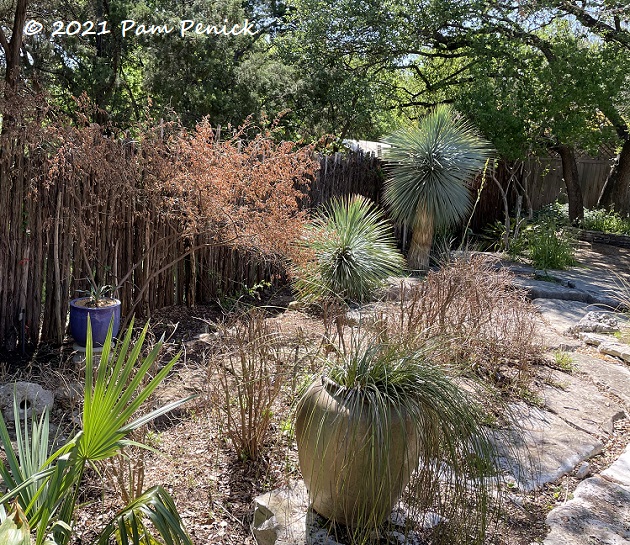
- Loropetalum chinense ‘Plum’ – Chinese fringeflower (east & west borders): All the leaves turned brown, but recently the bigger one (east side) began putting out new leaves on the upper branches. It’s very sparse, but I’m hopeful for a recovery. The other one
looks dead. Update 4/14: A few new leaves on the west one too! I haven’t pruned them and will keep watching. - Loropetalum chinense ‘Rubrum’ – Chinese fringeflower (front-island bed): All the leaves turned brown, but recently it put out a few leaves. It’s extremely sparse, however, and I’m not convinced it will recover. I’ll keep watching and haven’t pruned it.
- Loropetalum chinense ‘Sizzling Pink’ – Chinese fringeflower (lower garden): Killed, I think. This was my biggest and most beautiful loropetalum. There are no signs of life on the branches or at the roots, only brown leaves.
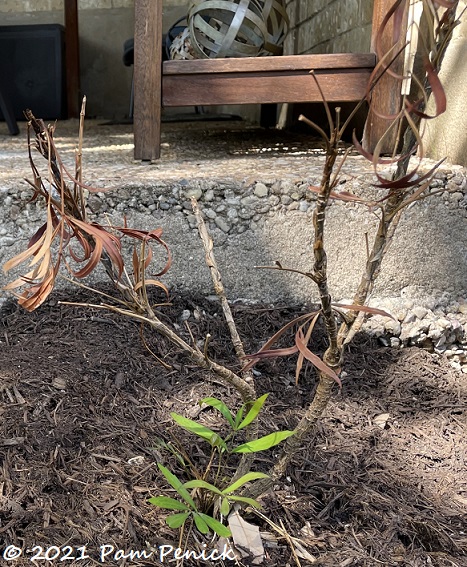
- Mahonia eurybracteata ‘Soft Caress’ – ‘Soft Caress’ mahonia: Killed to the ground, but new growth is slowly appearing at the roots of about half my plants. The others appear to be dead.
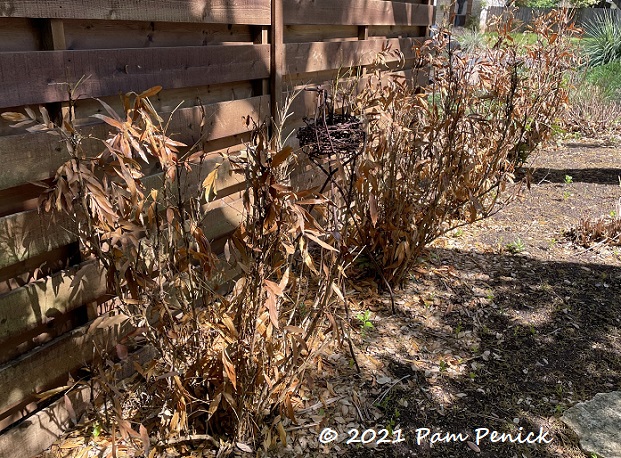
- Mahonia fortunei – Chinese mahonia: Killed back. My hedge of 7 plants immediately turned brown and held onto their dead leaves — not a good sign. But as of last week, sprigs of green leaves are appearing on some of the dead-looking stems. I hope they will eventually fully releaf. I’m waiting a while longer before doing any pruning.
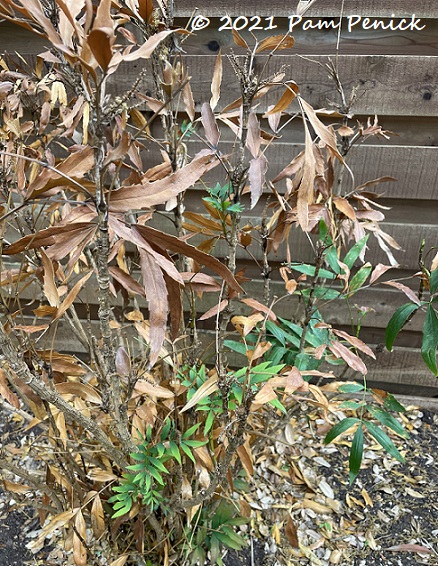
- Mahonia x media ‘Marvel’ – ‘Marvel’ mahonia: Killed in a pot left outdoors.
- Mahonia trifoliolata – Agarita*: One branch at the top turned brown, and I cut it off. But the rest remains green, and it looks healthy.
- Malpighia glabra ‘Nana’ – Dwarf Barbados cherry*: Killed to the roots. There are a few small signs of green at the roots, but nothing vigorous. I’ve pruned it back by half (as usual) and am continuing to watch it.
- Malvaviscus arboreus var. drummondii – Turk’s cap*: Died back, as per normal. I cut it back hard, and it’s coming back quickly.
- Malvaviscus arboreus var. drummondii ‘Pam Puryear’ – Pam’s Pink Turk’s cap*: Died back, as per normal. I cut it back hard, and it’s coming back quickly.
- Malvaviscus arboreus var. drummondii ‘Alba’ – White Turk’s cap*: Died back, as per normal. I cut it back hard, and it’s coming back quickly.
- Malvaviscus x ‘Big Momma’ – ‘Big Momma’ Turk’s cap*: Died to the ground and slow to recover, but a few sprigs have recently appeared from the roots.
- Myrtus communis ‘Nana’ – Dwarf myrtle: Slowly went brown after the freeze and was killed to the roots. Sprigs of green soon appeared at the base, so I cut it back hard and am waiting to see if it can recover.
- Pavonia hastata – Pale pavonia: Killed. This one hurts, as I used it throughout my front garden because it thrives in shade, deer ignore it, and it’s semi-evergreen. It’s always a self-seeder, and seedlings are coming up. But no signs of life on the defoliated woody stems, which I cut back by half in late February as usual.
- Phlomis fruticosa – Jerusalem sage: Killed to the roots, but vigorous new growth is coming up. This should look decent again by midsummer.
- Phlomis lanata – Dwarf, or littleleaf, Jerusalem sage: Killed, but this plant never thrived anyway. I won’t replace.
- Pittosporum ‘Cream de Mint’: Killed to just below the snow line. A little new growth is struggling up at the roots, but the verdict is still out on this one.
- Podocarpus macrophyllus – Japanese yew: I planted this the week before the freeze and mulched it well. It got browned a bit but overall looks good. (For the record, mature specimens around town have died.)
- Podocarpus macrophyllus ‘Pringles Dwarf’ – ‘Pringles’ dwarf Japanese yew: I planted this the week before the freeze and mulched it well. It suffered significant browning but has new growth.
- Poliomintha longiflora – Mexican oregano: No discernable damage. Looks good.
- Punica granatum ‘Peppy Le Pom’ – ‘Peppy Le Pom’ dwarf pomegranate: Killed to the roots and is slowly putting out new growth.
- Rosa ‘Peggy Martin’ – ‘Peggy Martin’ rose, aka Katrina rose: Killed to the roots except for one cane with a few sprigs of green leaves. New growth is coming up quickly from the roots.
- Rosmarinus officinalis – Rosemary: Killed. I replaced my big, mature plant with a tiny, 1-gallon ‘Arp’ cultivar, which is said to be fairly cold hardy.
- Sabal minor – Texas dwarf palmetto*: No damage whatsoever, and it’s one of the few large “shrubs” that remained green.
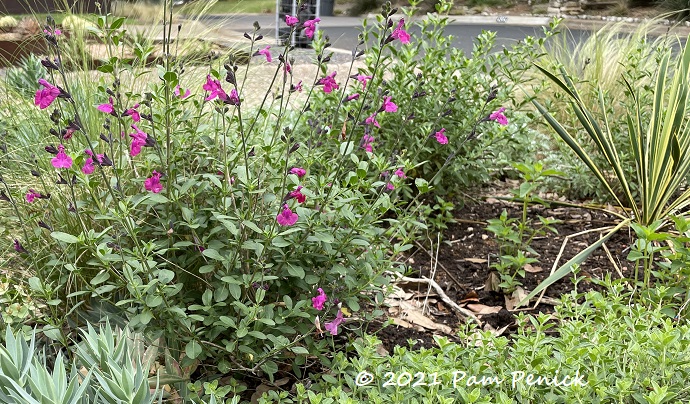
- Salvia greggii – Autumn sage*: Died to the roots. I pruned it to the ground, and now it’s coming back quickly. Some have even started to bloom.
- Tecoma x ‘Orange Jubilee’ – Orange bells, or orange esperanza: Killed.
- Thuja orientalis ‘Franky Boy’ – ‘Franky Boy’ arborvitae: No damage and looks healthy. This is a novelty plant I’m trialing after seeing a striking mature specimen at Dallas Arboretum.
- Viburnum rufidulum – Rusty blackhaw viburnum*: I planted this a week before the freeze and covered it with a cardboard box. No damage whatsoever, and it bloomed soon after the thaw.
Up next are Perennials. Click for my earlier post about Trees.
__________________________
Digging Deeper
Come learn about gardening and design at Garden Spark! I organize in-person talks by inspiring designers, landscape architects, authors, and gardeners a few times a year in Austin. These are limited-attendance events that sell out quickly, so join the Garden Spark email list to be notified in advance; simply click this link and ask to be added. Season 8 kicks off in fall 2024. Stay tuned for more info!
All material © 2025 by Pam Penick for Digging. Unauthorized reproduction prohibited.


I had largely similar results in Dallas as you did in Austin. I did lose my two large bay laurels (Laurus nobilis) and three Viburnum tinus. Interestingly, my regular turk’s cap (M. arboreus var. drummondii) is coming back very slowly, while my Big Mama turk’s cap started coming back early and vigorously.
Interesting about the Turk’s cap reversals in your garden compared with mine, Peter. And bummer about your big shrub losses. Shrubs, screening plants, and the like definitely took the hardest hit.
My bay laurel was small and appears to be toast, but the more established one I planted at the neighbors’ is shockingly sending up new growth from the roots. It looks like the top is completely dead, but I’m waiting to touch it because cardinals have nested in it.
It’s good the birds are finding all those dead twigs useful, right?
It’s my pittosporum I am really hoping for. I have two very old specimens (perhaps dating from the 1954 house construction). It will be heart-breaking if we lose those. No signs yet one way or the other.
I’m sorry, Astra. Pittosporum got walloped by this freeze event.
I’m sorry Pam. That’s a tremendous number of losses. I’d have never thought that anything could kill rosemary.
Thanks, Kris. This was my biggest category of losses or damage. Many of my now-unsightly plants are trying to recover. Time will tell if they can manage it. I hope so. It would be too many to replace.
Odd that I had two nights in a row bottoming out at 5 degrees and my Jerusalem sage had little to no damage. My Mediterranean Fan Palm was severely damaged and the growing spear came out with just a slight tug which means death for most palms. Since this palm can have more than one growing trunk I am waiting to see if it branches off before giving up on it.
I had my Otatea (Mexican weeping bamboo) covered with the old style xmas lights that give off heat – BUT I had no electricity! I had other cover on it though and it is sending up emergency shoots from the ground. I have lost 2 of these expensive bamboo’s in past years so I am thankful the roots survived this time.
I don’t recall you mentioning your weeping bamboo lately – do you still have it and did it make it through?
I am astounded that your Mexican weeping bamboo survived in any way. I lost mine (first one, and then its replacement) in “normal” deep freezes before giving up on it altogether, as they are so expensive to replace. How I miss it though!
It may help that I am growing the Mexican weeping bamboo in front of the south wall of my house and had it extensively covered. I’ve never found it for less than 100 dollars even when in small pots. My Alphonse Karr bamboo had no protection and died to the ground but is sending up a few rescue shoots.
My clumping Graceful bamboo – Bambusa textilis Gracilis also unprotected and I have them in a row for privacy and the ones at the north end of the row suffered the most, but they are sending up rescue shoots.
My black bamboo -Phyllostachys nigra did well with only a few canes dead but running bamboo tends to be more cold tolerant than the clumpers. The black bamboo is the only bamboo I have growing under oak trees – all the others are in full sun all day.
Helpful info. Thanks for sharing, James.
I’m in east Austin. Lost 2 huge 50-year-old pittosporums, a hedge of Sandankwa viburnums (man, they had a bad odor after the freeze, too), & lots of Huntington Carpet prostrate rosemary, but am otherwise surprised by what is coming back. I had to cut down bay laurels, star jasmine, firecracker fern, sweet almond verbena, plumbago, dwarf Barbados cherry, & oakleaf hydrangea, & all are coming back from the roots (the pavonia hastata might be growing from reseeding, not sure). Some plants, like a pomegranate & 2 pineapple guavas, are just now beginning to show life on the branches & growth from the roots, so I’m glad I hadn’t removed them. A Texas torchwood that I thought was toast is leafing out fine now–so glad that I was patient & didn’t remove it, too. Was surprised to see a Burgundy Hearts redbud produce such an enormous amount of seedpods, an unusual sight.
Thank you so much for posting post-freeze updates! It means a lot to compare notes, be encouraged to be patient, & join in celebration of what has survived!
In my garden, Pavonia hastata is coming up from seedlings too, I think, not from the roots of the existing plants. But still, I’m grateful for it. I’m glad you’re seeing so much regrowth, Kate. I’m sorry about the pitts, viburnums, and rosemary though.
I seem to have about 80% of my Sandankwa viburnum hedge coming back from the ground. But I can confirm the dead leaves stink! I thought my dog had left a surprise somewhere, and I just couldn’t find it!
I think this is the last blog post of yours’ or anyone’s that I’ve read, though I had only bookmarked to the post on your trees. Your lists of the ATX big freeze on different posts are very helpful. Back to catching up over a cool drink!
I’m glad it’s helpful, David. And hopefully I’ll never have to compile another freeze list like this again.
Living in rural western Cooke County, my lowest temperature during the two weeks was -5 degrees. I am most surprised by the response of my Texas Sage (the standard silver/gray variety and a newer ‘Heavenly Cloud’), both at least six years old. Both must be regrown from the base. The same is true for my American Beautyberry. The top growth of my Bambusa Phyllostachys ‘Henon’ was killed, but it has regrown like gangbusters from the roots. In a clump of seven Japanese Black Pine, grown several years from seedlings supplied by a bonsai artist, two had moderate browning of needles, but new candles are green and mostly normal, perhaps slightly smaller than candles on the other five. I am very pleased that my in-ground Vitex has flourished, requiring only minor tip pruning. Of two pre-bonsai Vitex in large training pots and only slightly protected outdoors, one has flourished and the other is at last sending forth numerous shoots after I drastically cut it back and aerated the root system slightly. Vitex must be a tough plant!